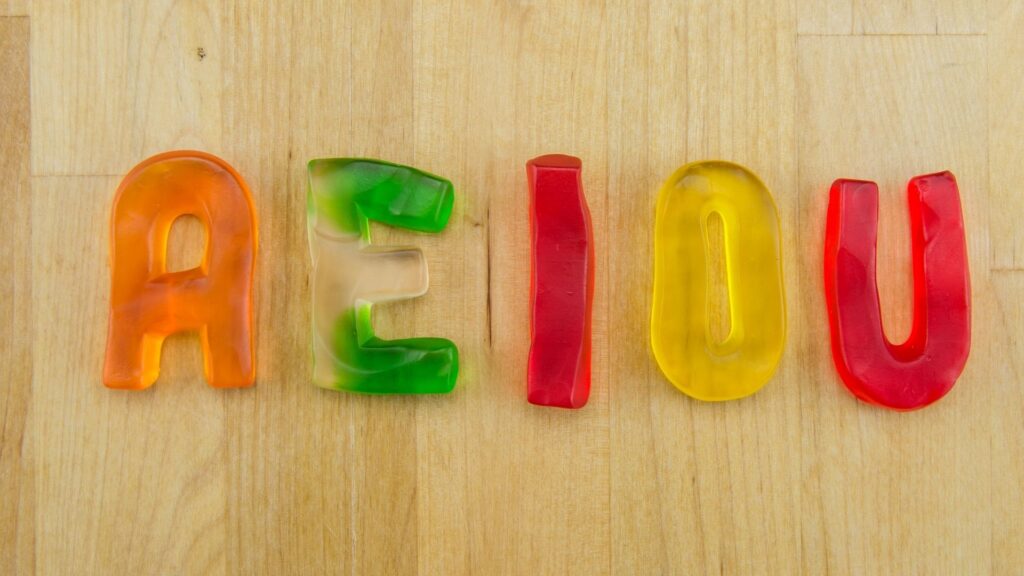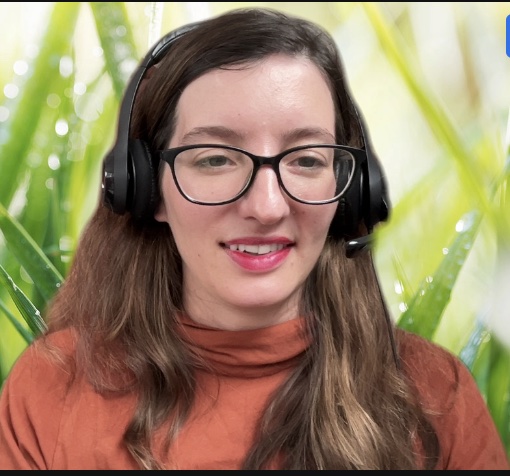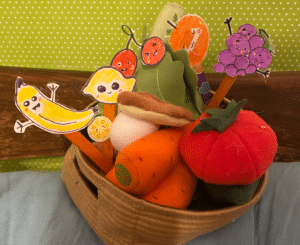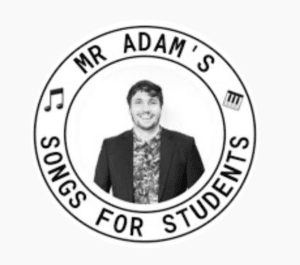Let’s talk about some fun games to teach kids vowel sounds! I have adapted some of these for teaching vowels to online students. Young learners, especially, will benefit from these simple vowel activities. But teachers can use these vowel activities to teach students of any age.
First, let’s get some basics out of the way. What are vowels and why do they matter?

What are vowels?
The alphabet is composed of two kinds of letters: vowels and consonants. The vowels in English are AEIOU. In a linguistic sense, the vowels are produced by a comparatively open configuration of the vocal tract, with the vibration of the vocal cords but without audible friction.

Why should we teach vowels separately?
You can’t make words without them! For a fun challenge, you can string a bunch of consonants together and have the kids guess the words. It is often impossible! Vowels are the foundation for reading and writing English. You can’t have words without vowels.

That’s why CVC constructions are the basis of early reading skills. Then, we often teach long vowels and short vowels to aid students in decoding while reading.
So, let’s dive right into some engaging ways to teach vowel letters to readers.
Fun Activities to Teach Vowel Sounds
Make a Vowel Face
Draw a vowel face (a and e for the eyes, i for the nose, u for the mouth, and o is the entire face) or use letter magnets to be creative and make some vowel faces!
A,E,I,O,U
Sing “Apples and Bananas”
The “Apples and Bananas” song helps ELL learners, as well as early readers of all backgrounds, learn their vowel sounds in a really fun way. Songs are a great way to teach vowel sounds to kids and even adults because they are easy for anyone to remember. Also, it’s a great opportunity to be silly and have fun, keeping the student engaged!
Remember to alter the vowels in each line. Use scaffolding methods to help the student become independent in their vowel usage. First, sing the refrain or chorus of the song for the child. Then sing an example of the chorus line together while inputting another vowel sound. Finally, have the student input their own vowels and build their own lyrics!
Here is the song using the I do, We do, You Do scaffolding method
“Apples and Bananas” Song Lyrics:
I do (Teaching Sings)
I like to eat, eat, eat, apples and bananas.
I like to eat, eat, eat, apples and bananas.
We do (the teacher and student sings):
“I like to eat, eat, eat, apples and bananas,
I like to eat, eat, eat, apples and bananas.”
Now let’s sing with the “long a” sound!
I like to ate, ate, ate, ay-ples and ba-nay nays.
I like to ate, ate, ate, ay-ples and ba-nay nays.
You do (The student sings independently), Your turn!
“I like to ate, ate, ate, ay-ples and ba-nay nays,
I like to ate, ate, ate, ay-ples and ba-nay nays.”
Now let’s sing with the “long e” sound!
I like to eat, eat, eat, ee-ples and bee nee nees.
I like to eat, eat, eat, ee-ples and bee nee nees.
”I like to eat, eat, eat, ee-ples and bee nee nees,
I like to eat, eat, eat, ee-ples and bee nee nees.”
Now let’s sing with the “long i” sound!
I like to ite, ite, ite, ii-ples and bii nii niies.
I like to ite, ite, ite, ii-ples and bii nii niies.
(I like to ite, ite, ite, ii-ples and bii nii niies.)
(I like to ite, ite, ite, ii-ples and bii nii niies.)
Now let’s sing with the “long o” sound!
I like to ote, ote, ote, op-ples and bo-no-nos.
I like to ote, ote, ote, op-ples and bo-no-nos.
“I like to ote, ote, ote, op-ples and bo-no-nos,
I like to ote, ote, ote, op-ples and bo-no-nos.”
Now let’s sing with an the “long u” sound!
I like to ute, ute, ute, up-ples and bu-nu-nus.
I like to ute, ute, ute, up-ples and bu-nu-nus.
“I like to ute, ute, ute, up-ples and bu-nu-nus,
I like to ute, ute, ute, up-ples and bu-nu-nus.”
Chorus
I like to eat, eat, eat, apples and bananas.
I like to eat, eat, eat, apples and bananas.
Read some fun CVC books
Hop on Pop by Dr. Seuss is fantastic for teaching vowel sounds.
Bright Hub Education has a great lesson plan to teach Hop on Pop, too.
Ask students lots of questions to identify the long vowel and short vowel sounds. Print out worksheets if possible, or just ask them to write the words on the screen if you are teaching online.
Short O Vowel Sound: “hop” and “pop”. Can you think of two more words that have this short o vowel sound?
Short a Vowel Sound: “cat” and “hat”. Can you think of two more words that have the short a vowel sound?
Short e Vowel Sound: “bed” and “red” have short e vowel sounds. Can you think of more words that have this short e vowel sound?
Teach the Bossy ‘e’ Rule
Some companies call it the bossy e rule because the letter “e” makes the vowel say its name. Personally, I find that rather aggressive! If someone is bossy, I don’t want to teach kids that it is OK to give the bossy person what they want. When I was younger, I was taught the same rule using a kinder story.
Sometimes called the “magic e” rule; the vowel ____ e pattern makes a long vowel sound. Create a long vowel sound by putting an ‘e‘ on the end of the word.
“Anyone who does anything to help a child in his life is a hero to me.”
Fred Rogers (Mister Rogers ❤️ )











